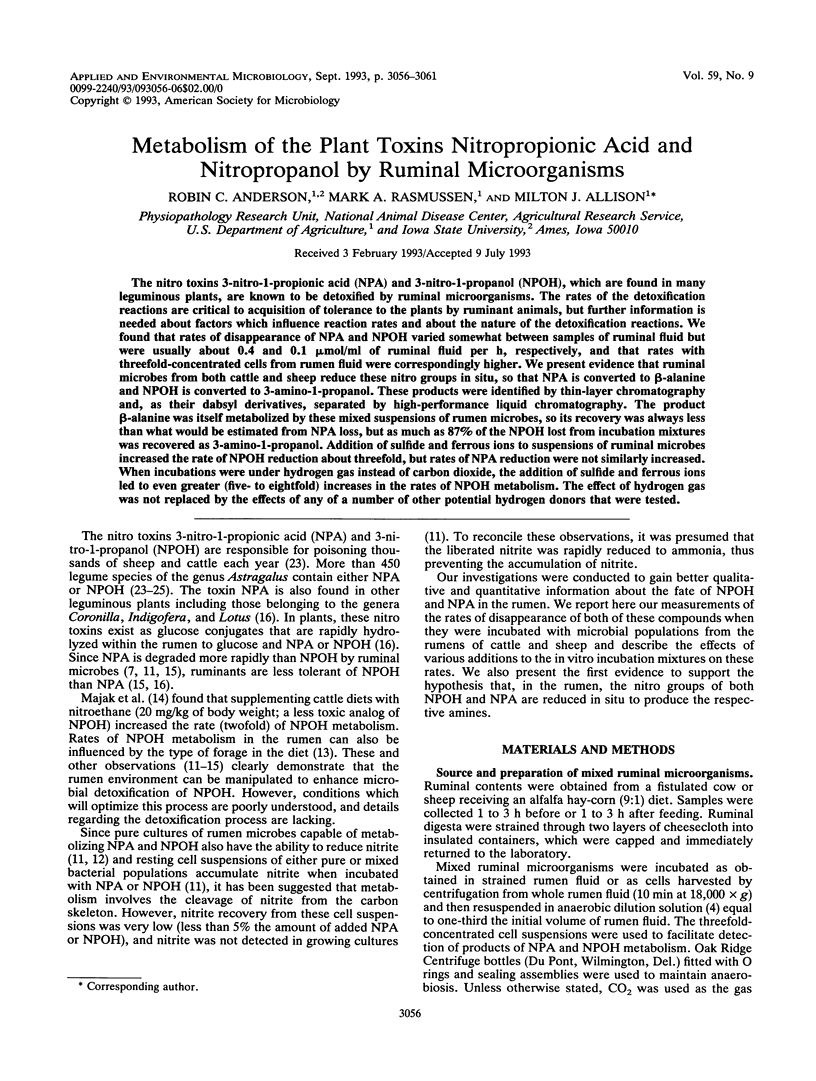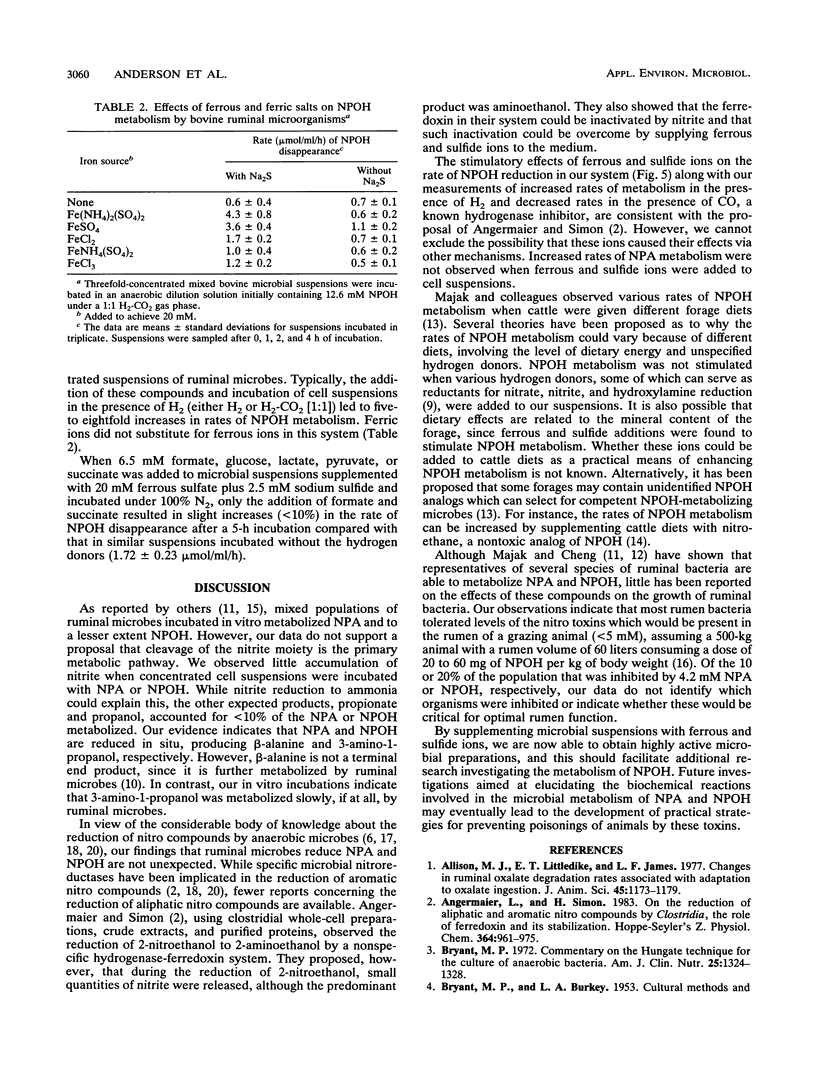Abstract
The nitro toxins 3-nitro-1-propionic acid (NPA) and 3-nitro-1-propanol (NPOH), which are found in many leguminous plants, are known to be detoxified by ruminal microorganisms. The rates of the detoxification reactions are critical to acquisition of tolerance to the plants by ruminant animals, but further information is needed about factors which influence reaction rates and about the nature of the detoxification reactions. We found that rates of disappearance of NPA and NPOH varied somewhat between samples of ruminal fluid but were usually about 0.4 and 0.1 mumol/ml of ruminal fluid per h, respectively, and that rates with threefold-concentrated cells from rumen fluid were correspondingly higher. We present evidence that ruminal microbes from both cattle and sheep reduce these nitro groups in situ, so that NPA is converted to bet-alanine and NPOH is converted to 3-amino-1-propanol. These products were identified by thin-layer chromatography and, as their dabsyl derivatives, separated by high-performance liquid chromatography. The product beta-alanine was itself metabolized by these mixed suspensions of rumen microbes, so its recovery was always less than what would be estimated from NPA loss, but as much as 87% of the NPOH lost from incubation mixtures was recovered as 3-amino-1-propanol. Addition of sulfide and ferrous ions to suspensions of ruminal microbes increased the rate of NPOH reduction about threefold, but rates of NPA reduction were not similarly increased. When incubations were under hydrogen gas instead of carbon dioxide, the addition of sulfide and ferrous ions led to even greater (five- to eightfold) increases in the rates of NPOH metabolism.(ABSTRACT TRUNCATED AT 250 WORDS)
Full text
PDF





Selected References
These references are in PubMed. This may not be the complete list of references from this article.
- Allison M. J., Littledike E. T., James L. F. Changes in ruminal oxalate degradation rates associated with adaptation to oxalate ingestion. J Anim Sci. 1977 Nov;45(5):1173–1179. doi: 10.2527/jas1977.4551173x. [DOI] [PubMed] [Google Scholar]
- Angermaier L., Simon H. On the reduction of aliphatic and aromatic nitro compounds by Clostridia, the role of ferredoxin and its stabilization. Hoppe Seylers Z Physiol Chem. 1983 Aug;364(8):961–975. doi: 10.1515/bchm2.1983.364.2.961. [DOI] [PubMed] [Google Scholar]
- Bryant M. P. Commentary on the Hungate technique for culture of anaerobic bacteria. Am J Clin Nutr. 1972 Dec;25(12):1324–1328. doi: 10.1093/ajcn/25.12.1324. [DOI] [PubMed] [Google Scholar]
- LEWIS D. The metabolism of nitrate and nitrite in the sheep. 2. Hydrogen donators in nitrate reduction by rumen micro-organisms in vitro. Biochem J. 1951 Jul;49(2):149–153. doi: 10.1042/bj0490149. [DOI] [PMC free article] [PubMed] [Google Scholar]
- Majak W., Cheng K. J., Hall J. W. Enhanced degradation of 3-nitropropanol by ruminal microorganisms. J Anim Sci. 1986 Apr;62(4):1072–1080. doi: 10.2527/jas1986.6241072x. [DOI] [PubMed] [Google Scholar]
- Majak W., Cheng K. J. Identification of rumen bacteria that anaerobically degrade aliphatic nitrotoxins. Can J Microbiol. 1981 Jul;27(7):646–650. doi: 10.1139/m81-099. [DOI] [PubMed] [Google Scholar]
- Manning B. W., Campbell W. L., Franklin W., Delclos K. B., Cerniglia C. E. Metabolism of 6-nitrochrysene by intestinal microflora. Appl Environ Microbiol. 1988 Jan;54(1):197–203. doi: 10.1128/aem.54.1.197-203.1988. [DOI] [PMC free article] [PubMed] [Google Scholar]
- Rafil F., Franklin W., Heflich R. H., Cerniglia C. E. Reduction of nitroaromatic compounds by anaerobic bacteria isolated from the human gastrointestinal tract. Appl Environ Microbiol. 1991 Apr;57(4):962–968. doi: 10.1128/aem.57.4.962-968.1991. [DOI] [PMC free article] [PubMed] [Google Scholar]
- Richardson K. E., Fu P. P., Cerniglia C. E. Metabolism of 1-, 3-, and 6-nitrobenzo[a]pyrene by intestinal microflora. J Toxicol Environ Health. 1988;23(4):527–537. doi: 10.1080/15287398809531134. [DOI] [PubMed] [Google Scholar]
- Salanitro J. P., Muirhead P. A. Quantitative method for the gas chromatographic analysis of short-chain monocarboxylic and dicarboxylic acids in fermentation media. Appl Microbiol. 1975 Mar;29(3):374–381. doi: 10.1128/am.29.3.374-381.1975. [DOI] [PMC free article] [PubMed] [Google Scholar]
- Schneider N. R., Yeary R. A. Measurement of nitrite and nitrate in blood. Am J Vet Res. 1973 Jan;34(1):133–135. [PubMed] [Google Scholar]
- Williams M. C., James L. F., Bond B. O. Emory milkvetch (Astragalus emoryanus var emoryanus) poisoning in chicks, sheep, and cattle. Am J Vet Res. 1979 Mar;40(3):403–406. [PubMed] [Google Scholar]


